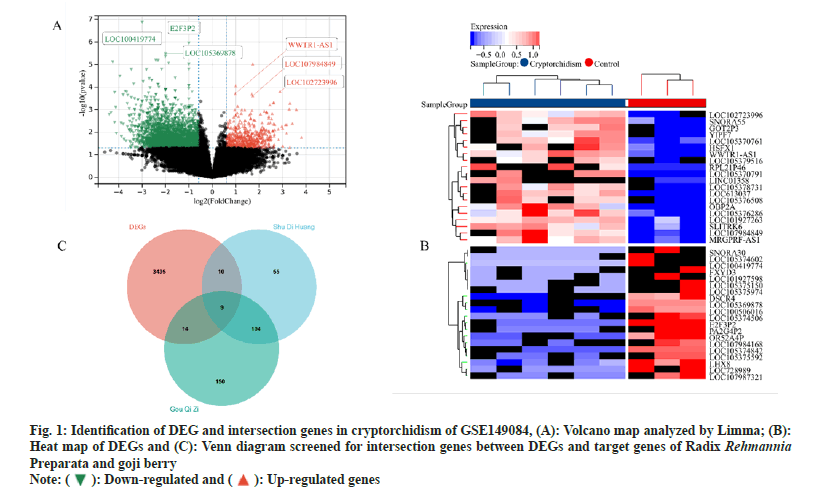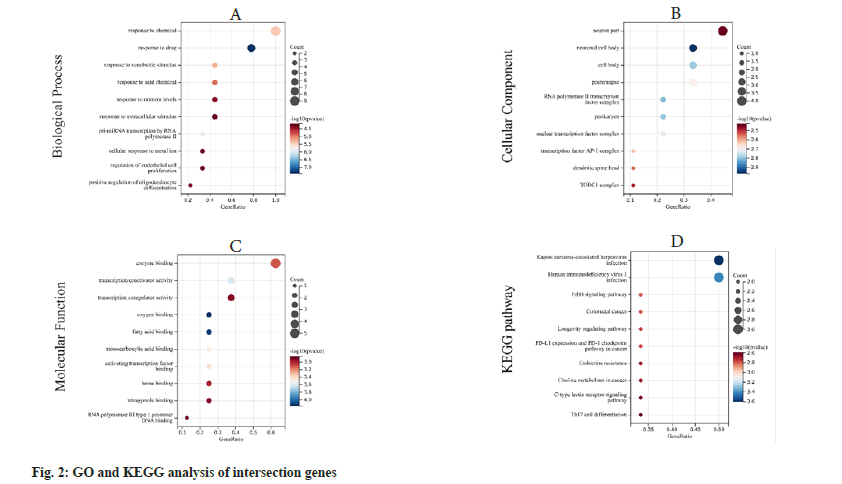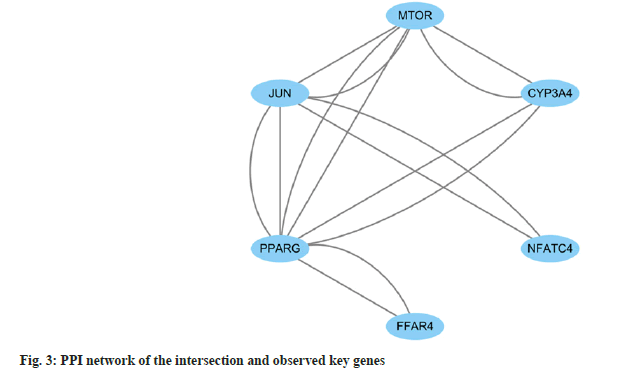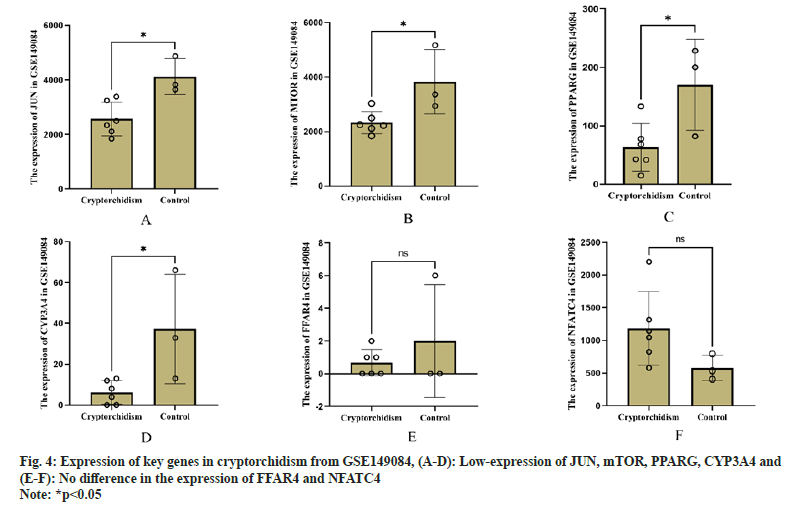- *Corresponding Author:
- Wenze Li
Department of Urology, Xiangtan Hospital, Xiangtan, Yuetang 411101, China
E-mail: Liwenze13@163.com
| This article was originally published in a special issue, “Drug Discovery and Repositioning Studies in Biopharmaceutical Sciences” |
| Indian J Pharm Sci 2024:86(4) Spl Issue “235-240” |
This is an open access article distributed under the terms of the Creative Commons Attribution-NonCommercial-ShareAlike 3.0 License, which allows others to remix, tweak, and build upon the work non-commercially, as long as the author is credited and the new creations are licensed under the identical terms
Abstract
This study explored the key genes of cryptorchidism by using Radix Rehmannia Preparata and goji berry to provide basis for the study of pathogenic genes in cryptorchidism. Differentially expressed genes were identified by Limma analysis from GSE149084 dataset. The genes targeting Radix Rehmannia Preparata and goji berry were obtained from Traditional Chinese Medicine Systems Pharmacology Database and Analysis Platform. Venn diagram screened the intersection genes of Radix Rehmannia Preparata and goji berry. Gene Ontology and Kyoto Encyclopedia of Genes and Genomes analyzed the intersecting genes while the protein-protein interactions network screened the key genes. The expression of key gene was analyzed using GSE149084 dataset. 3468 differentially expressed genes were identified, which included 660 upregulating and 2808 down-regulating genes; 2883 differentially expressed genes in GSE149084 dataset. Venn diagram screened 9 intersection genes in differentially expressed genes, Radix Rehmannia Preparata and goji berry. The intersection genes were significantly correlated with response to drug, response to chemical, neuron part and enzyme binding (p<0.05). However, Kyoto Encyclopedia of Genes and Genomes was significantly correlated with Kaposi sarcoma-associated herpes virus and human immunodeficiency virus 1 infection, erythroblastic oncogene B signaling pathway, colorectal cancer, longevity regulating pathway, programmed cell death ligand expression and programmed cell death protein pathway in cancer (p<0.05). Radix Rehmannia Preparata and goji berry might be beneficial in the adjuvant therapy of cryptorchidism by targeting the key genes. This study suggests that jun proto-oncogene, activator protein-1 transcription factor subunit, mechanistic target of rapamycin, peroxisome proliferator activated receptor gamma and cytochrome P450 family 3 subfamily A member 4 become the novel key genes for predicted cryptorchidism.
Keywords
Adjuvant therapy, cryptorchidism, Radix Rehmannia Preparata, goji berry
Cryptorchidism is the phenomenon in which the testicles of the fetus fail to migrate along the peritoneal sheath process through the inguinal canal during normal development, resulting in one or both testicles not being able to descend into the same side of the scrotum[1,2]. It is the most common type of congenital malformation in male reproductive system. The incidence of cryptorchidism in full-term infants ranges from 2 %-9 %, with slightly different rates reported in different countries[3,4]. Cryptorchidism is an important risk factor for adult male infertility and testicular tumors, which can be clinically manifested as cryptorchidism alone or combined with deformities in other parts of the body[1,5]. It’s etiology may be related to genes, hormone synthesis and secretion, anatomy, and other environmental factors[6]. In the recent years, research on cryptorchidism has mainly focused on the relationship between pathogenic or susceptibility genes and environmental factors with cryptorchidism. Research has shown that cryptorchidism belongs to congenital developmental abnormalities and some children may have other accompanying conditions congenital abnormalities in certain parts of the body[6,7]; genetic factors also play an important role in their occurrence and development[8]. Treatment of cryptorchidism includes medication and surgery[9]. Drug treatments used include human Chorionic Gonadotropin (hCG) or Gonadotropin Releasing Hormone (GnRH) to induce testicular descent with a success rate of approximately 20 %[9]; however, there is a risk of retraction. Traditional Chinese Medicine (TCM) has effective adjunctive therapeutic effects in many chronic diseases such as tumors and pain[10]. Radix Rehmannia Preparata and Lycium barbarum (goji berry or Chinese wolfberry fruit) can promote the secretion of hormones in the brain, tonify the kidneys and essence, and has the effect of awakening the brain[11,12]. Therefore, their therapeutic effect assists in the treatment of cryptorchidism; however their mechanism of action is still unknown. The possible mechanism of Radix Rehmannia Preparata and goji berry is to assist in regulating certain genes of cryptorchidism. In this study, we identified Differentially Expressed Genes (DEGs) in cryptorchidism and control groups. Then we searched for adhesive Rehmannia root, goji berry targeted genes on the Traditional Chinese Medicine Systems Pharmacology (TCMSP) (https://old.tcmsp-e.com/ tcmsp.ph) database. Further, we screened for intersection genes between DEGs and target genes. Finally, Protein-Protein Interaction (PPI) network was constructed to screen the key genes. Data was collected from transcriptome data and corresponding clinical data related to cryptorchidism were collected from GSE149084 dataset obtained from Gene Expression Omnibus (GEO) database (https:/http:// ww.ncbinlm.nih.gov/geo/). GSE149084 dataset included 6 cryptorchidism and 3 control samples. The targeted genes of Radix Rehmannia Preparata and goji berry were obtained (fig. 1). Screening of DEGs and intersection genes was carried out. Guanine Cytosine (GC) RNA-sequencing ID data was downloaded from GSE149084 dataset. DEGs were identified by using the Limma package of R software, version 3.6.3 (http://www.rproject.org/). The threshold for identifying significant DEGs was False Discovery Rate (FDR) <0.01 and|log2 (fold change)|≥1.5. Intersection genes were screened by Venn diagram in DEGs and target genes of Radix Rehmannia Preparata and goji berry. Gene Ontology (GO) and Kyoto Encyclopedia of Genes and Genomes (KEGG) enrichment analysis was studied. GO analysis includes Biological Process (BP), Molecular Function (MF) and Cellular Component (CC) while KEGG is the advanced function and mechanisms involved in the biological system at the molecular level. We analyzed the key DEGs function and mechanisms pathway though Database for Annotation, Visualization and Integrated Discovery (DAVID) platform (http://david.ncifcrf.gov/) and p<0.05 was considered to be statistically significant. PPI network and key genes were identified. GeneMANIA (http://genemania.org/) prediction server was designed to assess the PPI network; it was analyzed and visualized by cytoscape 3.6.1 (http:// www.cytoscape.org/). In PPI network, a high degree value indicated more essential role for the key genes. The degree value of each gene was calculated by the network analyzer tool that was built using the cytoscape software. Genes whose degree value, closeness centrality and betweenness were greater than the median value were identified as key genes. Statistical analysis was conducted for which student’s t-test and Pearson’s correlation coefficient (R function t-test) were performed to determine the significant differences between the two groups where p<0.05 was considered to be statistically significant. grammar of graphics plot (ggplot) package was used for plotting the graphs. Further, identification of DEGs and intersection genes in cryptorchidism were carried out. Based on the set criteria, we identify 3468 DEGs, including 660 up-regulated and 2808 down-regulated genes and 2883 DEGs in GSE149084 dataset (fig. 2A and fig. 2B). Screening for intersection genes between DEGs and target genes of Radix Rehmannia Preparata and goji berry (fig. 2C). They are Solute Carrier Family 6 member 1 (SLC6A11), Neuroglobin (NGB), Nuclear Factor of Activated T Cells 4 (NFATC4), Jun proto-oncogen (JUN), Activator Protein (AP)-1 transcription factor subunit, Cytochrome P450 family 3 subfamily A member 4 (CYP3A4), Hippocalcin (HPCA), Peroxisome Proliferator Activated Receptor Gamma (PPARG), mechanistic Target of Rapamycin (mTOR), Free Fatty Acid Receptor 4 (FFAR4). The intersection genes for GO and KEGG were analyzed though DAVID software. BP, CC and MF were significantly correlated with response to drug, chemical, neuron part and enzyme binding (p<0.05). However, KEGG was significantly correlated with Kaposi sarcomaassociated herpes infection, human immunodeficiency virus 1 infection, Erythroblastic oncogene B (ErbB) signaling pathway, colorectal cancer, longevity regulating pathway, Programmed cell Death Ligand 1 (PD-L1) and Programmed cell Death (PD-1) protein 1 checkpoint pathway in cancer (p<0.05) (fig. 3). PPI network was constructed which included 9 intersection genes was generated using the GeneMANIA platform. Removal of marginal genes, we obtained 6 genes. We analyzed betweenness value and identified the key genes as JUN, mTOR, PPARG, CYP3A4, FFAR4 and NFATC4 (fig. 4). The expression of key genes in cryptorchidism was studied. The genes, JUN, mTOR, PPARG and CYP3A4 were low in cryptorchidism from GSE149084 database (p<0.05). However, the expression of FFAR4 and NFATC4 showed no difference in cryptorchidism and control groups (p>0.05). Cryptorchidism is the most common congenital defect in the male urinary system it and is one of the triggering factors for male infertility and testicular cancer[13]. At present, surgical intervention is mostly used for the treatment of cryptorchidism patients in clinical practice and efforts are made to perform testicular fixation surgery before the age of 18 mo in order to maximize fertility, and reduce the risk of developing testicular cancer in the future[14]. In recent years, research on cryptorchidism has mainly focused on pathogenic genes and environmental factors, but its pathogenesis has not yet been elucidated; more research and exploration are urgently needed[15]. TCM emphasizes the differentiation and treatment for symptoms and signs[16]. It believes that the occurrence of cryptorchidism is mainly due to insufficient innate endowment of the human body, deficiency of kidney essence, which leads to testicular dysplasia[17]. Therefore, patients can take the prescription of Bushen San formula as treatment which contains Gastrodia elata, Uncaria, Eucommia, Radix Scutellaria and kuding. Similarly, patients adopted a prescription composed of multiple TCMs such as Radix Rehmannia Preparata and goji berry, which promotes the secretion of hormones in the brain, tonifies the kidneys and essence which has the effect of opening the mind and awakening the mind[18,19]. This TCM formula has a relatively high clinical therapeutic value and is also a commonly used method, but it needs to be selected appropriately according to the patient’s own condition. In this study, we identified DEGs in cryptorchidism and then we screened the intersection genes in DEGs. Further, the target genes of adhesive Rehmannia root and Chinese wolfberry fruit were studied. The genes, JUN, mTOR, PPARG and CYP3A4 as hub gene was screened by PPI network which showed low expression in cryptorchidism samples. JUN, a gene on chromosome 1 with HGNC number 6204, is a transformation gene of avian sarcoma virus 17[20]. It encodes a protein highly similar to the viral protein and interacts directly with specific target DNA sequences to regulate gene expression. JUN positive regulation of RNA polymerase II promoter transcription involved in cell response to anisomycin and chemical stimuli[21]. Expressing in multiple structures, including the digestive system, central nervous system, urinary and reproductive system, long bones, and sensory organs[21]. mTOR is the main regulatory molecule for cell growth and metabolism, which can promote synthetic metabolic processes such as ribosome biogenesis, protein, nucleotide, fatty acid, and lipid synthesis, and inhibit catabolic metabolic processes such as autophagy[22]. In addition, overactivation of the mTOR pathway by upstream signals is common in human cancer[23]. During tumor development, proteins Phosphatidylinositol 3-Kinase (PI3K) and Protein kinase B (Akt) that promote tumor formation are overexpressed, leading to continuous activation of the mTOR signaling pathway[24]. In addition, Phosphatase and Tensin homolog (PTEN), Tuberous Sclerosis Complex (TSC) 1/2 and Liver Kinase B1 (LKB1) are upstream negative regulatory factors of mTOR and the dysfunction of these proteins may be one of the reasons for the activation of mTOR signaling pathway during tumor development[23]. PPAR forms heterodimers with Retinoid X Receptors (RXR), which regulate the transcription of various genes[25]. Three subtypes of PPAR known are, PPARAlpha (α), PPAR-Delta (δ) and PPAR-Gamma (γ)[25]; protein encoded by this gene is PPAR-γ. It is a regulatory factor for adipocyte differentiation. In addition, PPAR-γ is related to the pathology of many diseases, including obesity, diabetes, atherosclerosis and cancer. Variable splicing transcriptome variants encoding different subtypes have been described[26]. Moreover, PPARG can regulate the production of adipocyte related genes, has anti-inflammatory and anti-tumor effects[27]. CYP3A4 is a major cytochrome P450 enzyme in the human liver and intestines, accounting for approximately 25 % of the total P450 enzymes in the adult liver[28]. Many drugs, endogenous compounds and environmental pollutants in the body are metabolized by CYP3A4[28]. There are approximately 38 categories and >150 drugs that are its substrates, including antiepileptic drugs, antipsychotic drugs, macrolide antibiotics, antifungal drugs, Histamine (H1) receptor antagonists, Hydroxymethylglutaryl-Coenzyme A (HMG-CoA) reductase inhibitors, benzodiazepines, proton pump inhibitors, calcium channel blockers and anti-tumor drugs, etc. CYP3A4 is involved in 60 % of drug metabolism in the body and is the most abundant drug metabolizing enzyme in the human body[29]. JUN, mTOR, PPARG and CYP3A4 as the key genes, denoted significantly low-expression in cryptorchidism. Importantly, they are correlated with urinary and reproductive system, and sensory organs. We consider that the Rehmannia root and Chinese wolfberry fruit in the adjuvant therapy of cryptorchidism is closely related to the key genes JUN, MTOR, PPARG and CYP3A4.
Funding:
This work was supported by Health Research Project of Hunan Provincial Health Commission (Grant no: C2019139).
Conflict of interests:
The authors declared no conflict of interests.
References
- Leslie SW, Sajjad H, Villanueva CA. Cryptorchidism. StatPearls Publishing; 2024.
- Bishop BM, Anderson KM. Cryptorchidism review for the primary care provider. SD Med 2023;76(5):222-8.
[Google Scholar] [PubMed]
- Docimo SG, Silver RI, Cromie W. The undescended testicle: Diagnosis and management. Am Fam Physician 2000;62(9):2037-48.
[Google Scholar] [PubMed]
- Nguyen V, Ngo L, Jaqua EE. Cryptorchidism (undescended testicle). Am Fam Physician 2023;108(4):378-385.
[Google Scholar] [PubMed]
- Husmann DA. Cryptorchidism: What are the risks of infertility? What do we tell the parents? How do we manage the child? J Urol 2022;207(3):498-9.
[Crossref] [Google Scholar] [PubMed]
- Elamo HP, Virtanen HE, Toppari J. Genetics of cryptorchidism and testicular regression. Best Pract Res Clin Endocrinol Metab 2022;36(1):1-10.
[Crossref] [Google Scholar] [PubMed]
- Montero AJ, González AL, Hernández-Martín S, Anaut BM. Cryptorchidism and spermatic pathway complete dissociation. ANZ J Surg 2022;92(5):1273-74.
[Crossref] [Google Scholar] [PubMed]
- Oreshkina EM, Bolotova NV, Pylaev TE, Averyanov AP, Raygorodskaya NY. Hormonal and genetic causes of cryptorchidism. Probl Endokrinol 2023;69(5):99-106.
[Crossref] [Google Scholar] [PubMed]
- Ceccanti S, Migliara G, de Vito C, Cozzi DA. Prevalence, management, and outcome of cryptorchidism associated with gastroschisis: A systematic review and meta-analysis. J Pediatr Surg 2022;57(7):1414-22.
[Crossref] [Google Scholar] [PubMed]
- Hempen CH, Hummelsberger J. Traditionelle Chinesische Medizin (TCM)-vom Mythos zur Evidenz. Bundesgesundheitsblatt Gesundheitsforschung Gesundheitsschutz 2020;63(5):570-6.
- Liu C, Ma R, Wang L, Zhu R, Liu H, Guo Y, et al. Rehmanniae Radix in osteoporosis: A review of traditional Chinese medicinal uses, phytochemistry, pharmacokinetics and pharmacology. J Ethnopharmacol 2017;198:351-62.
[Crossref] [Google Scholar] [PubMed]
- Lee HS, Choi CI. Black goji berry (Lycium ruthenicum murray): A review of its pharmacological activity. Nutrients 2023;15(19):1-12.
[Crossref] [Google Scholar] [PubMed]
- Zhang D, Ma M, Pu Y, Li L, Cao G, Bai Y, et al. Genetic association between IL-21 polymorphisms and cryptorchidism in a Chinese Han population. Genet Test Mol Biomarkers 2016;20(5):261-4.
[Crossref] [Google Scholar] [PubMed]
- Virtanen HE, Bjerknes R, Cortes D, Jørgensen N, de Meyts RE, Thorsson AV, et al. Cryptorchidism: Classification, prevalence and long-term consequences. Acta Paediatr 2007;96(5):611-6.
[Crossref] [Google Scholar] [PubMed]
- Xie X, Hu J, Liu L, Lei P, Zhang P, Ran C, et al. Bibliometric analysis of scientific publications on cryptorchidism: Research hotspots and trends between 2000 and 2022. Heliyon 2023;9(9):1-12.
[Crossref] [Google Scholar] [PubMed]
- Huang Z, Miao J, Chen J, Zhong Y, Yang S, Ma Y, et al. A traditional Chinese medicine syndrome classification model based on cross-feature generation by convolution neural network: Model development and validation. JMIR Med Inform 2022;10(4):1-10.
[Crossref] [Google Scholar] [PubMed]
- Sang X, Wang Z, Liu S, Wang R. Relationship between Traditional Chinese Medicine (TCM) constitution and TCM syndrome in the diagnosis and treatment of chronic diseases. Chin Med Sci J 2018;33(2):114-9.
[Crossref] [Google Scholar] [PubMed]
- Jia J, Chen J, Wang G, Li M, Zheng Q, Li D. Progress of research into the pharmacological effect and clinical application of the traditional Chinese medicine Rehmanniae Radix. Biomed Pharmacother 2023;168:115809.
[Crossref] [Google Scholar] [PubMed]
- Ma Z, Zhang H, Teh S, Wang C, Zhang Y, Hayford F, et al. Goji berries as a potential natural antioxidant medicine: An insight into their molecular mechanisms of action. Oxid Med Cell Longev 2019;1-12.
[Crossref] [Google Scholar] [PubMed]
- Zhou C, Martinez E, di Marcantonio D, Solanki-Patel N, Aghayev T, Peri S, et al. JUN is a key transcriptional regulator of the unfolded protein response in acute myeloid leukemia. Leukemia 2017;31(5):1196-205.
[Crossref] [Google Scholar] [PubMed]
- Li QV, Dixon G, Verma N, Rosen BP, Gordillo M, Luo R, et al. Genome-scale screens identify JNK-JUN signaling as a barrier for pluripotency exit and endoderm differentiation. Nat Genet 2019;51(6):999-1010.
[Crossref] [Google Scholar] [PubMed]
- Liu GY, Sabatini DM. mTOR at the nexus of nutrition, growth, ageing and disease. Nat Rev Mol Cell Biol 2020;21(4):183-203.
[Crossref] [Google Scholar] [PubMed]
- Tian T, Li X, Zhang J. mTOR signaling in cancer and mTOR inhibitors in solid tumor targeting therapy. Int J Mol Sci 2019;20(3):1-12.
[Crossref] [Google Scholar] [PubMed]
- He Y, Sun MM, Zhang GG, Yang J, Chen KS, Xu WW, et al. Targeting PI3K/Akt signal transduction for cancer therapy. Signal Transduct Target Ther 2021;6(1):1-15.
[Crossref] [Google Scholar] [PubMed]
- Wagner N, Wagner KD. The role of PPARs in disease. Cells 2020;9(11):1-10.
[Crossref] [Google Scholar] [PubMed]
- Liu Y, Wang J, Luo S, Zhan Y, Lu Q. The roles of PPARγ and its agonists in autoimmune diseases: A comprehensive review. J Autoimmun 2020;113:1-10.
[Crossref] [Google Scholar] [PubMed]
- Li D, Liu X, Tian X, Liu F, Yao X, Dong J. PPARG: A promising therapeutic target in breast cancer and regulation by natural drugs. PPAR Res 2023;1-12.
[Crossref] [Google Scholar] [PubMed]
- Zhao M, Ma J, Li M, Zhang Y, Jiang B, Zhao X, et al. Cytochrome P450 enzymes and drug metabolism in humans. Int J Mol Sci 2021;22(23):1-10.
[Crossref] [Google Scholar] [PubMed]
- Zhou SF. Drugs behave as substrates, inhibitors and inducers of human cytochrome P450 3A4. Curr Drug Metab 2008;9(4):310-22.
[Crossref] [Google Scholar] [PubMed]









